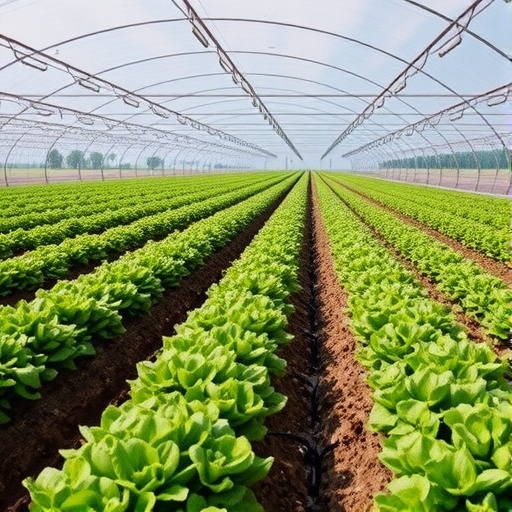Per- and polyfluoroalkyl substances (PFAS), often referred to as “forever chemicals,” have become an alarming presence in agricultural landscapes and food supply chains, raising significant concerns regarding their persistent and bioaccumulative nature. These synthetic compounds, which encompass nearly 15,000 variants, were first introduced in industrial and consumer products in the 1940s. Their exceptional chemical stability and resistance to degradation have enabled them to infiltrate environmental media, including soil and water, ultimately entering crops and livestock systems that support global food production.
PFAS have been widely used in a variety of applications such as firefighting foams, non-stick cookware coatings, food packaging, and textile treatments due to their unique ability to repel oil and water. However, their molecular architecture—characterized by strong carbon-fluorine bonds—grants them a remarkable persistence in the environment. As a result, once PFAS enter agricultural ecosystems, they exhibit long residence times, creating chronic exposure risks that are difficult to mitigate or reverse.
A critical pathway for PFAS contamination in farming environments includes the application of wastewater effluents and biosolids derived from municipal and industrial waste streams. These byproducts often contain PFAS residues, which, when introduced to agricultural soils, provide a steady source of chemical input. Moreover, irrigation with contaminated water and atmospheric deposition—especially proximal to PFAS-production industrial facilities—contribute to their widespread presence in farmlands. These diverse entry points make the control and prevention of PFAS accumulation in agriculture a complex challenge.
Once incorporated into the soil matrix, PFAS compounds show varying degrees of mobility depending on their chain length and chemical structure. Short-chain PFAS possess enhanced water solubility and lower sorption affinity to soil particles, facilitating their uptake into plant roots and transport within crops. This increased bioavailability in the rhizosphere means that vegetables, grains, and certain fruits are vulnerable to accumulating high concentrations of these substances, posing direct food safety concerns. In parallel, livestock exposed to contaminated feed or water may bioaccumulate PFAS in tissues, milk, and eggs, amplifying human exposure through animal-based products.
The toxicological profile of PFAS underscores their serious impact on human health. Extensive toxicology studies have linked exposure to these chemicals with immune system suppression, hepatic and renal toxicity, endocrine disruption, and elevated cancer risk. The insidious nature of PFAS contamination lies in their ubiquity and persistence, which leads to bioaccumulation and biomagnification along the food chain. Consequently, the continual ingestion of PFAS-laden foodstuffs represents a sustained public health hazard that demands urgent scientific and regulatory attention.
Regulatory frameworks addressing PFAS contamination in agricultural contexts remain nascent and fragmented globally. The European Union has taken preliminary steps toward setting maximum allowable limits for these chemicals in food products, but many jurisdictions, including the United States, have yet to establish comprehensive policies or enforceable standards. This regulatory lag complicates efforts to protect consumers and manage ongoing contamination risks, underscoring the need for harmonized international governance.
In addition to regulatory action, technological advancements are crucial for addressing PFAS pollution. Current remediation strategies for contaminated soils and waters include adsorption, ion exchange, and advanced oxidation processes; however, their effectiveness varies depending on the PFAS species and environmental conditions. Research focused on developing scalable, cost-effective soil and water treatment technologies is imperative to limit PFAS bioavailability in agricultural systems and to remediate existing contamination hotspots.
Monitoring programs designed to detect and quantify PFAS in agricultural matrices are another cornerstone of effective management. Implementing systematic surveillance in soils, water bodies, food products, and animal tissues can provide critical data for risk assessment and guide interventions. Such monitoring requires sensitive analytical techniques capable of distinguishing among the extensive variety of PFAS compounds, including both long-chain and emerging short-chain variants.
Collaboration across multiple sectors is essential to combat PFAS infiltration in agriculture. Farmers, scientists, policymakers, and public health advocates must work together to define sustainable agricultural practices that minimize PFAS inputs and promote soil and crop health. Public awareness campaigns can empower consumers to make informed choices, while fostering political will for stringent regulations and investment in innovative remediation research.
Ignoring the persistent and pervasive threat of PFAS contamination will likely result in long-term ecological damage and heightened human health burdens. As these substances accumulate silently in foundational food systems, their impacts could undermine agricultural sustainability and trust in food safety globally. Addressing this challenge head-on with proactive measures represents an urgent priority for the scientific community and society at large.
The article titled Per- and polyfluoroalkyl substances in agriculture: environmental fate, bioaccumulation and management presents a comprehensive perspective on the pathways, risks, and potential solutions associated with PFAS in agricultural environments. Authored by Hui Li, Ph.D., professor at Michigan State University, the work calls for immediate action encompassing improved environmental monitoring, regulatory development, and remediation technology advancement to safeguard both human health and ecological integrity.
By dissecting the multifaceted issue of PFAS contamination, this perspective illuminates previously underappreciated routes of environmental pollution to the dinner table. It emphasizes the importance of considering agricultural systems as long-term reservoirs for these harmful substances, not merely endpoints of pollution. Recognizing the complex dynamics of PFAS environmental fate and bioaccumulation is foundational to devising effective management strategies.
To support further research and policy formation, open access dissemination of this work through the journal New Contaminants fosters worldwide accessibility to critical scientific insights on emerging pollutants like PFAS. Ensuring transparency and widespread availability of up-to-date scientific findings strengthens global capacity to address these chemical threats holistically.
The convergence of scientific innovation, collaborative governance, and public engagement holds the potential to mitigate PFAS contamination challenges. As awareness grows and technological tools improve, it is anticipated that actionable solutions will emerge to protect agricultural systems and secure food safety for future generations.
Subject of Research: Not applicable
Article Title: Per- and polyfluoroalkyl substances in agriculture: environmental fate, bioaccumulation and management
News Publication Date: 5-Sep-2025
Web References:
https://www.maxapress.com/newcontam
http://dx.doi.org/10.48130/newcontam-0025-0005
References:
Li H. 2025. Per- and polyfluoroalkyl substances in agriculture: environmental fate, bioaccumulation and management. New Contaminants 1: e006
Keywords: Agriculture, Agricultural chemistry, Agricultural engineering, Agricultural policy, Dietary counseling




